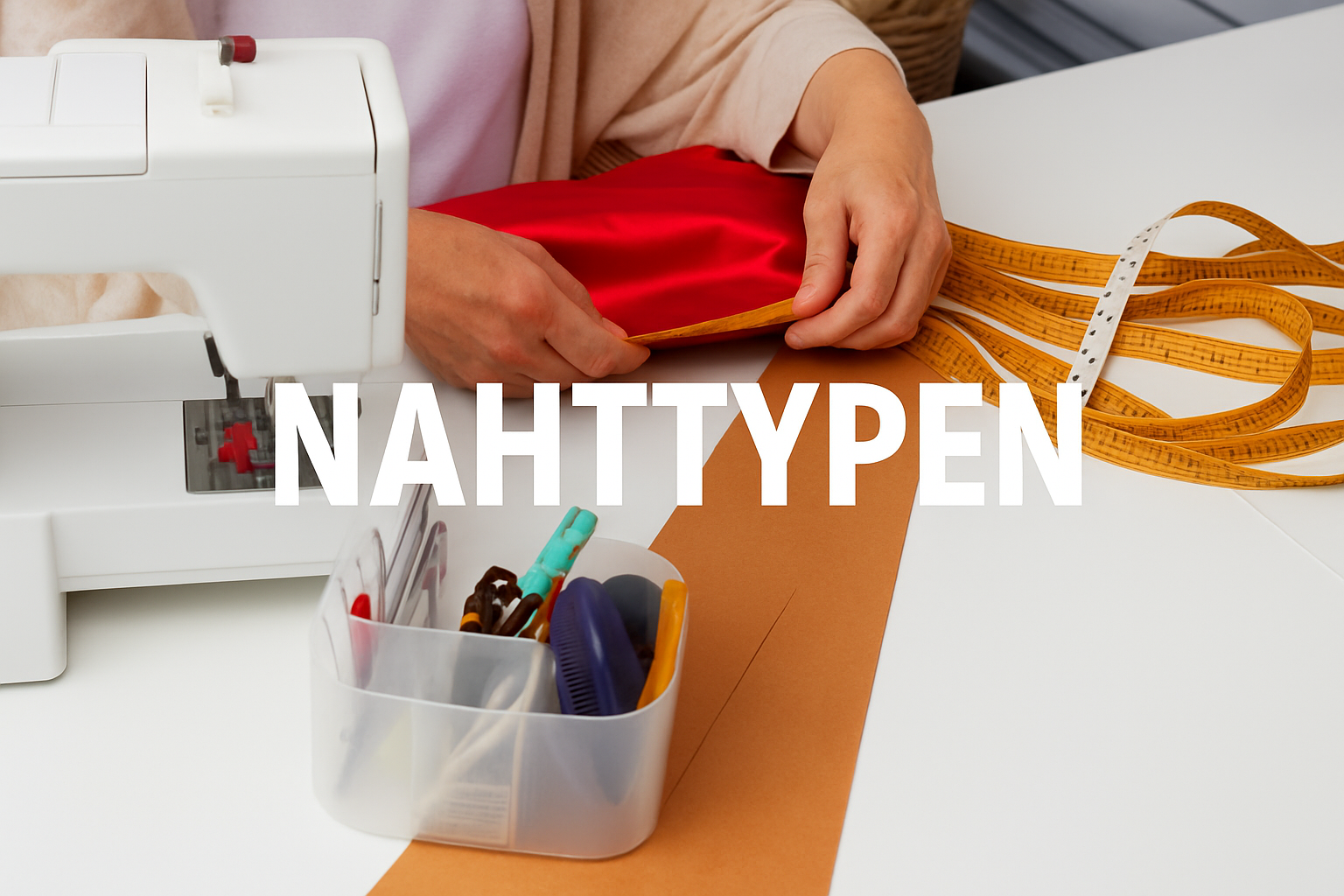The funny thing about clothes is that we all wear, wash, and sometimes complain about them. But most of us barely notice the thing that literally holds them together: the seams. In German, the word is Nahttypen. It sounds a bit technical and maybe even boring at first. But once you start paying attention, you realize seams are magical. They’re everywhere, invisible most of the time, and yet without them, we’d be standing around wrapped in fabric like awkward togas.
Honestly, I didn’t care about seams for most of my life. Who does? You throw on a T-shirt, you grab your jeans, that’s it. But one day, a backpack strap snapped mid-travel, and the seam gave way. I was in Rome, bags spilling onto cobblestones, cursing under my breath. And that’s when it hit me: seams matter. Maybe more than we think.
What exactly are Nahttypen?
Let’s not get lost in translation here. Nahttypen just means “types of seams.” Seams are simply where two (or more) pieces of fabric meet and are joined. Sounds simple, right? Two edges, some thread, done. But oh no, it’s not that simple. There are dozens of different seam types, each with its own personality, purpose, and even history.
Think of them like people. Some seams are strong and sturdy, like that friend who helps you move a couch up three flights of stairs. Others are delicate and elegant, more about appearance than muscle. Some are quick and sloppy but get the job done, while others are meticulous, precise, and almost artful.
Every day seam heroes
You’ve met these before, even if you didn’t realize it.
The Straight Stitch Seam
Plain, ordinary, everywhere. Your T-shirt side seam? Straight stitch. Your pillowcase? Probably straight stitch. It’s like the bread and butter of sewing. Not glamorous, but if it disappeared, the world would unravel. Literally.
The Flat-Felled Seam (Kappnaht)
Firm, tidy, no fraying edges. If you’ve ever worn jeans, you’ve seen this. Those neat double lines of stitching down the inside leg—that’s the flat-felled seam. Built for durability. The seam equivalent of a workhorse.
Funny story: My dad still wears a denim jacket he bought in the 1980s. The colors faded, and the buttons have been replaced, but the seams? Solid. Flat-felled, baby. This is proof that a good seam outlives fashion trends.
The French Seam
Ah, sophistication. The French seam hides all raw edges inside, leaving nothing visible. It’s the seam of silk blouses, bridal dresses, and delicate fabrics that fray easily. You don’t see it unless you turn the garment inside out, but it feels refined like a little secret luxury.
The Overlock Seam
If sewing were a superhero movie, the overlock machine would be the tech genius. It cuts, sews, and tidies the edge in one swoop, which is why store-bought clothes look so neat. The overlock seam is fast, efficient, and a little flashy. Once you notice it, you start spotting it everywhere.
Seams in the wild
Here’s something fun to try: next time you’re in a café or sitting on the subway, sneak a look at people’s clothes. Not in a creepy way. Just glance at the seams. You’ll spot double lines on jeans, overlock finishes on T-shirts, maybe even a hand-stitched hem on someone’s coat.
It’s a bit like birdwatching. Once you train your eyes, you can’t stop noticing. It also makes you appreciate how much quiet labor goes into what we wear daily.
Why do we even need different seam types?
Good question. Couldn’t we just stick with one seam for everything? Nope. Because fabrics behave differently. Denim laughs at a weak seam. Silk cries if you treat it too roughly. Stretch fabrics demand seams that move with them.
That’s why there are so many Nahttypen. Each one solves a problem:
- Preventing fraying.
- Adding strength.
- Allowing stretch.
- Making garments look neat inside.
- Or sometimes, just being decorative.
It’s like tools in a toolbox. You wouldn’t use a hammer to screw in a light bulb, right? Same idea.
Nerdy but cool: A closer look
Let’s geek out for a minute.
- The zigzag seam is perfect for stretchy stuff like jersey. It flexes with the fabric. Without it, your leggings would rip the first time you bent down.
- Blind hem seams are almost invisible from the outside. They are used in dress pants or skirts and are a magic trick of the sewing world.
- Bound seam: the edges are covered with fabric binding. Strong and stylish. Great for unlined jackets.
- Double-stitched seam: two lines of stitching side by side. Think of it as the belt-and-suspenders seam.
Every seam type is like an engineering choice—a balance between strength, flexibility, appearance, and speed. And honestly, once you learn about them, you start to feel like a detective looking inside clothes.
A little history (because stories make it real)
Before sewing machines, every seam was hand-sewn. Imagine that. A shirt could take weeks to make, every seam carefully stitched. People didn’t own dozens of clothes like we do now. They had a handful, and those had to last. So seams were reinforced, mended, patched.
The Industrial Revolution changed everything. Sewing machines made seams faster, stronger, and more uniform. Suddenly, clothing became cheaper and more widespread. And now we live in a world where you can buy a $5 T-shirt—held together by overlock seams running at lightning speed in a factory.
But here’s the twist: high fashion still treasures hand finishing. Couture houses will spend hours on a single French seam. They’ll tell you, “It gives soul to the garment.” Maybe that’s marketing, perhaps it’s true. But when you touch a handmade seam, you feel the difference.
Seems like a culture
I love this: in some traditions, seams aren’t just functional but decorative. Japanese sashiko stitching, initially a repair method, became an art form. In parts of Eastern Europe, decorative seams show off skill and style. Even denim culture celebrates exposed topstitching as part of its rugged aesthetic.
So, Nahttypen aren’t just technical—they’re cultural fingerprints. They tell us about values: durability, beauty, thrift, and status. A seam can say more than we think.
Everyday analogies
Seams are like… glue in a book. You don’t notice the spine until pages fall out. Or like trust in a friendship. Invisible most of the time, painfully obvious when it breaks.
And here’s a weird thought: your life is probably stitched together by invisible seams too. Routines, habits, relationships. You don’t see them, but they hold things in place. Maybe that’s why I find seams fascinating now. They’re such a good metaphor for stability.
FAQs about Nahttypen
Which seam lasts the longest?
Flat-felled seams. That’s why jeans are practically indestructible.
Which seam should beginners learn first?
The straight stitch. Seriously, it’s like learning to walk before running.
Do I need a fancy overlock machine?
Not unless you sew a lot. A regular machine with a zigzag can do most jobs.
Why do some clothes unravel so quickly?
Cheap finishing. Open seams, raw edges. Factories save seconds, but you lose quality.
Final stitches
So here’s my pitch: pay attention to seams. Not because you need to become a sewing expert, but because it makes you appreciate the invisible work around you. Every seam is a decision—strong or delicate, hidden or shown, quick or careful. Together, they form the hidden skeleton of fashion.
Next time you button your shirt, check the inside. Notice whether it’s messy or neat. Or touch your favorite pair of jeans and trace the strong double seams. These are little details, but they change how you see the world.
Because Nahttypen aren’t just about clothes. They’re about the quiet structures that hold things together, even when we’re too busy to notice. And maybe, just maybe, that’s worth celebrating.




